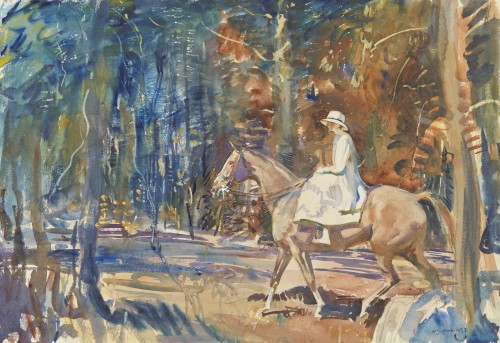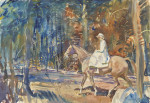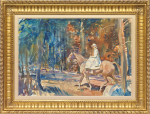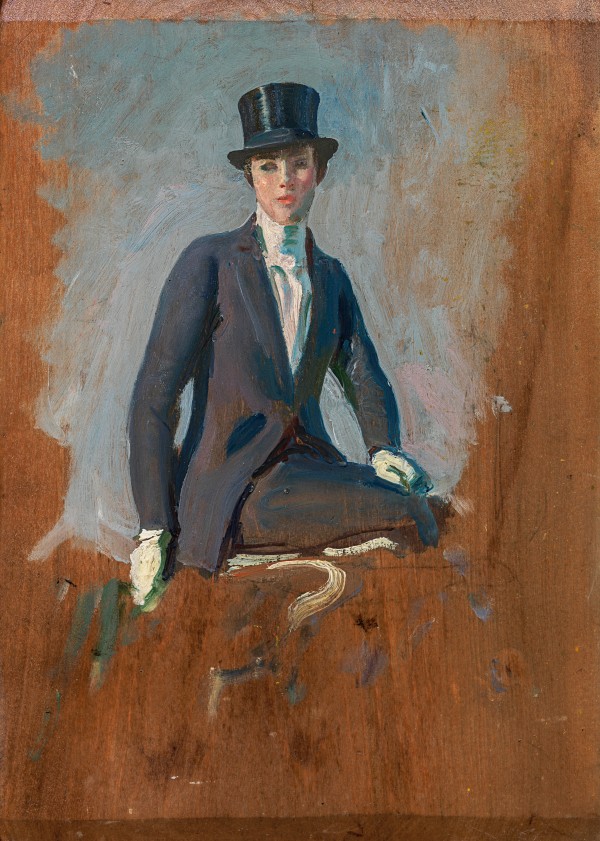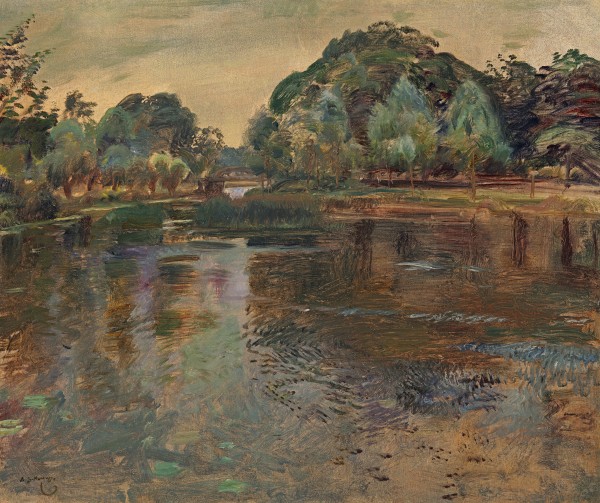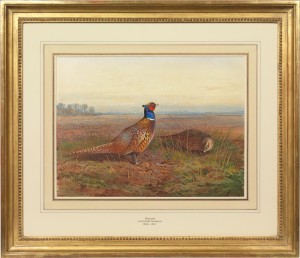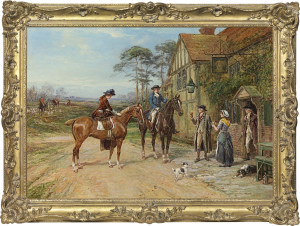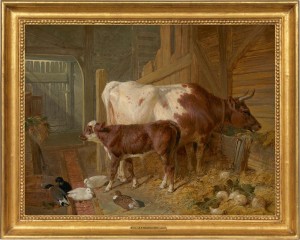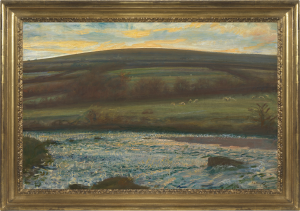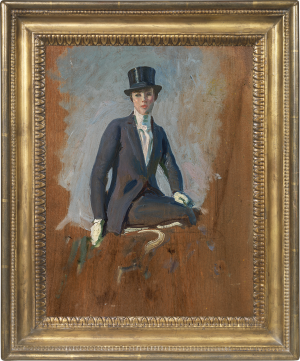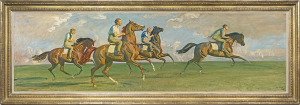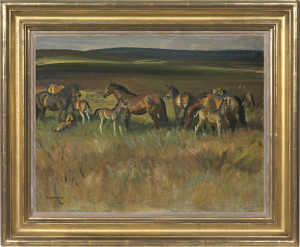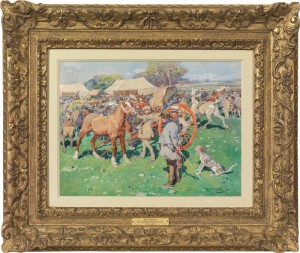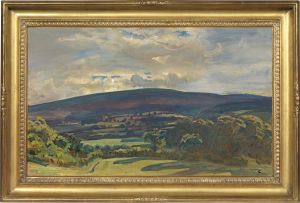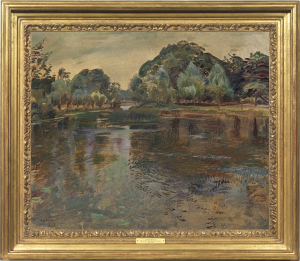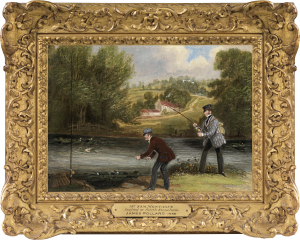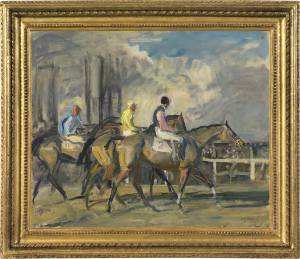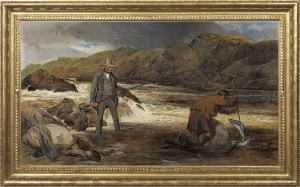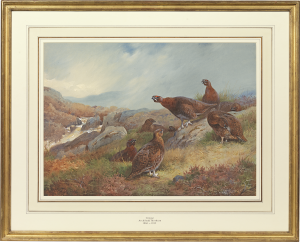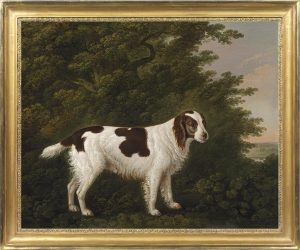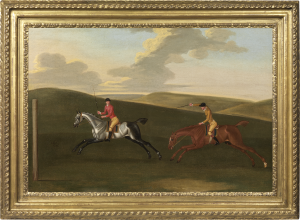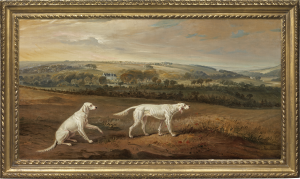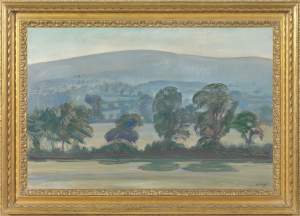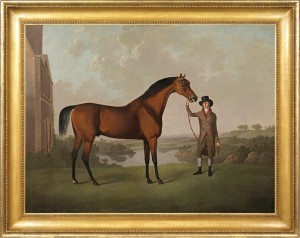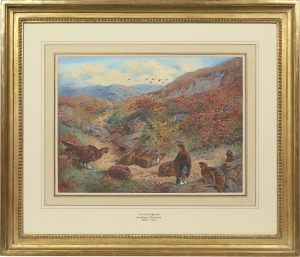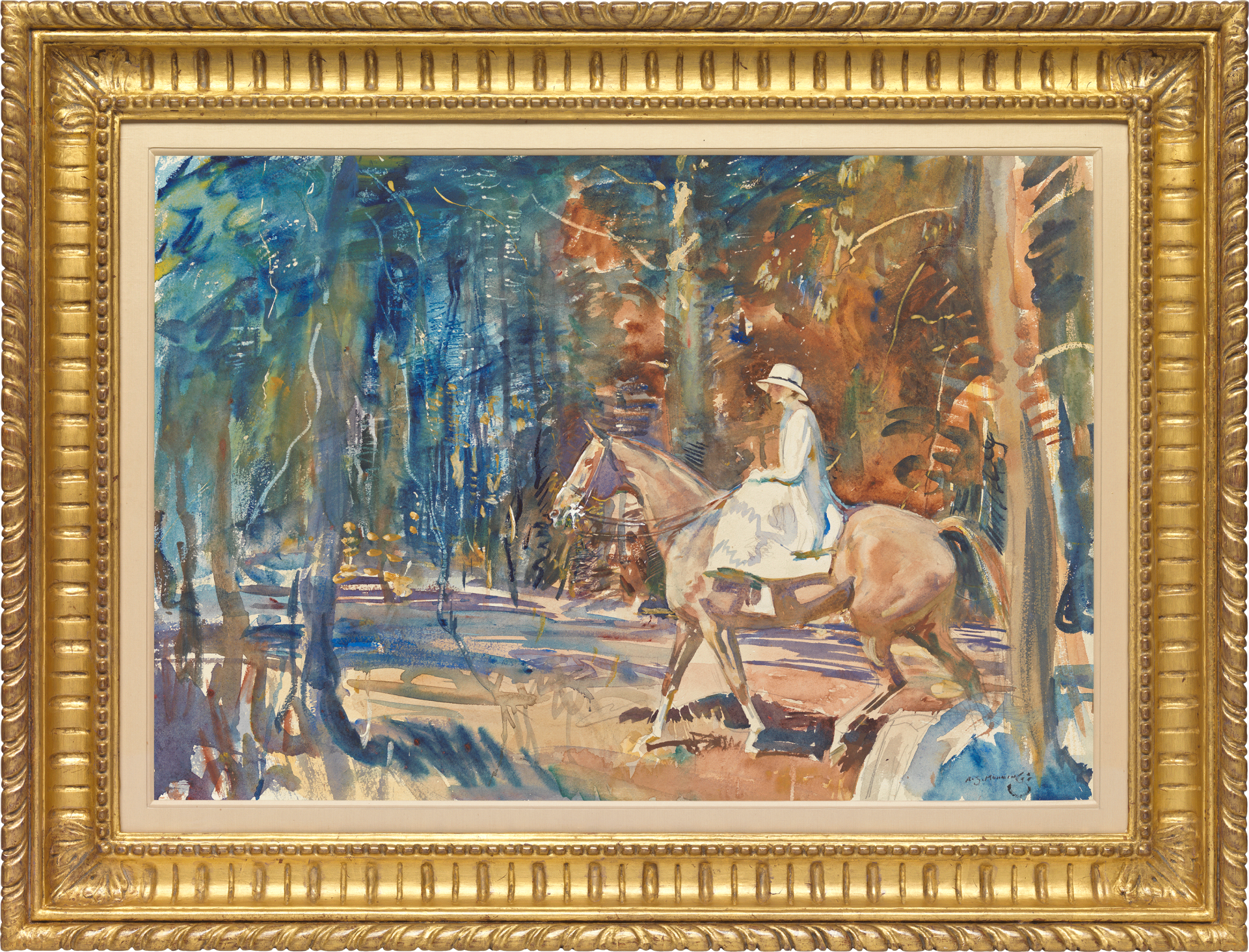Sir Alfred Munnings
Portrait of Mrs Frederick Henry Prince (1860-1949) in the New England woods
Pencil, watercolour and gouache: 14.5 x 21.3 (in) / 36.8 x 54 (cm)
Signed lower right: A.J.Munnings
This artwork is for sale.
Please contact us on: +44 (0)20 7493 3939.
Email us
SIR ALFRED MUNNINGS
Mendham 1878 - 1959 Dedham
Ref: BS 140
Portrait of Mrs Frederick Henry Prince (1860-1949) in the New England woods
Signed lower right: A.J.Munnings
Pencil, watercolour and gouache: 14½ x 21¼ in / 36.8 x 54 cm
Frame Size: 21 x 27½ x 2 in / 53.3 x 69.8 cm
Painted circa 1924
Provenance:
Sir Patrick Dunn
Richard Green, London, 1967
Christie’s London, 19th July 1968, lot 30
Ian McNicol, Glasgow
Private collection, UK
Exhibited:
Glasgow, The Royal Glasgow Institute of the Fine Arts, 1927 (sold for £70)
This watercolour of Mrs Prince shows Alfred Munnings’s wonderfully free and evocative watercolour technique, which here has parallels with the watercolours of John Singer Sargent. Munnings balances warm and cool tones, leaving the white paper bare to evoke Mrs Prince’s elegant white riding habit, modelling the figure with a few scribbles of lilac and blue shadow. The shimmering leaves and sunlight are described with rapid, wet washes, scratched in places with a knife or wooden brush handle to give more complex textures.
Riders in woodland with dappled sunlight were favourite motifs of Munnings, for example in the oil Hunting morning, 1913 (The Munnings Art Museum, Dedham) and in his oil portrait of his first wife Florence in Cornwall, The morning ride, c.1912 (private collection). Mrs Prince and her magnificent horse are seen in profile. She is relaxed and calm, with an effortless, patrician air: not for nothing was Munnings the most sought-after equestrian portraitist of his era.
The watercolour was probably made in 1924, during Munnings’s only visit to America. Invited to be a judge of the International Exhibition at the Carnegie Institute in Pittsburgh, Munnings was plunged into a round of high-society parties among the Prohibition-era East Coast élite, ‘gloriously mad days’ which also yielded a rich haul of subjects.
Abigail, née Kingsley Norman, was the wife of Frederick Henry Prince (1859-1953). The Boston-born contemporary of Andrew W Mellon and JP Morgan, he was one of the men who forged America’s economic might in the first half of the twentieth century, as stockbroker, railway magnate, owner of stockyards and meat-packing businesses in Chicago. Friend of President Roosevelt and Joe Kennedy, he was the oldest member of the New York, Boston and Midwest Stock Exchanges when he died aged ninety-three in 1953. Munnings had met Prince, who was Master of the fashionable Pau Foxhounds, at a Hunt dinner in Pau in 1920. He encountered Prince again while sailing to New York on the Berengaria, for the Princes, on their way back from hunting in Leicestershire, ‘thought no more of crossing the Atlantic than we would of crossing a street’[1].
Munnings was invited to stay at Princemere, the family’s estate at Wenham in Massachusetts, when his duties at the Carnegie Institute were over. Prince provided him with a specially-equipped studio and he painted a magnificent equestrian portrait of his host (with Richard Green in 2008; private collection) and another of Prince with his son Freddie. Munnings also made an oil portrait of Mrs Prince hunting with the Pau in a long, Victorian veil, which Freddie dubbed ‘Ma, crossin’ the Alps’[2].
In his autobiography, The Second Burst (1951), Munnings described Mrs Prince as ‘an original woman, with a strange turn of mind’[3], who would arrive hours late for dinner in spectacular Worth gowns, ‘thirty yards round the hemmed flounce’[4]. (Mrs Prince’s collection of couture is now in the Metropolitan Museum of Art, New York). He painted the Princes in Biarritz and Paris in 1932, noting once again Mrs Prince’s insouciant attitude to time, as she invariably arrived very late for sittings. ‘A more unperturbed woman I have never seen – there could be only one Mrs. Prince in the world’[5].
Frederick Henry Prince (1859-1953)
‘Frederick Henry Prince is generally regarded as New England’s richest citizen and Boston’s crustiest celebrity’, wrote Time magazine (no friend to Prince) in 1933[6]. Prince was born on 24th November 1859, the son of Frederick O Prince (1818-1899), who was twice Democratic Mayor of Boston. He left Harvard in his sophomore year and gained a seat on the New York Stock Exchange in 1885; FH Prince & Co installed the first stockticker in Boston. In 1884 he married Abigail Kingsley Norman (1860-1949), daughter of a wealthy waterworks builder.
Frederick Prince gained control of the Chicago Union Stock Yards in the era when more meat was processed in that city than anywhere else in the world. He bought into railways such as the Pere Marquette and Chicago Junction which transported livestock, thus safeguarding his supplies. Prince joked that although he ‘only owned four railroads, he controlled forty-six’, because his holdings connected the east and west coasts of America. In 1925 he helped Joseph P Kennedy to buy the Robertson-Cole/Film Book Offices, which evolved into RKO Pictures.
In 1933 Prince bought heavily into the famous Chicago meatpacking firm of Armour & Co, playing the trump card in the longstanding rivalry between the firms of Prince and Armour. He survived the Depression with a fortune of $250 million and presented President Roosevelt with the Prince Plan to consolidate the nation’s railways, saving $740 million annually. The plan was never inaugurated, because of the political cost of making thousands of railway workers redundant.
Prince had homes in Biarritz, Boston, Aiken, SC, a château near Pau, and the 994-acre Princemere estate in Pride’s Crossing, MA. In 1932 he bought the Marble Palace in Newport, Rhode Island from Mrs Oliver Belmont, the former Alva Vanderbilt, in Munnings’s words ‘because it will keep Mrs Prince amused for the next ten years in furnishing it….He says, having something to do like that keeps her young’[7].
A fearless sportsman, who survived being knocked unconscious from his runaway, four-horse tally-ho in 1908[8], Prince played polo, hunted, and co-founded the International Tennis Club of Washington and the National Steeplechase Association. From 1932 to 1936 he owned the beautiful J-class America’s Cup contender Weetamoe, losing in the 1934 trials to Harold Stirling Vanderbilt’s Rainbow.
Although Munnings portrays Prince as genial and generous, certainly one of his best patrons, he had a fiery temper. As Time noted in 1939, ‘in 1934 he paid some $15,000 damages for clopping behind the ear with a polo mallet an aged riding master who had ridden him off the ball in a pick-up polo match’[9].
SIR ALFRED MUNNINGS, PRA, RWS
Mendham 1878 - 1959 Dedham
Born in Mendham, Suffolk, Alfred Munnings was the son of a miller. He was apprenticed to a firm of lithographers from 1893 to 1898 and studied at the Norwich School of Art and in Paris. There he was impressed with plein-air naturalism; this, together with his introduction to the racecourse in 1899, influenced the themes for which he became famous.
While in Mendham, Munnings painted many scenes of country life, particularly horse fairs. He went to Cornwall in 1908, and for many years was an important addition to the Newlyn School of artists. When the First World War broke out, Munnings enlisted, despite having the use of only one eye owing to an accident in 1899. He became an army horse trainer near Reading and later went to France as an official war artist, attached to the Canadian Cavalry Brigade.
The year 1919 was a major turning-point in all aspects of Munnings’s life; he painted his first racehorse, Pothlyn, the winner of the Grand National, and became an Associate of the Royal Academy. He met Violet McBride, whom he was to marry, and bought Castle House, Dedham, where the Munnings Memorial Trust maintains a permanent exhibition of his pictures. Munnings’s prolific career, spanning over sixty years, brought him honour, with election to the Presidency of the Royal Academy in 1944, a Knighthood in 1945, and a personal award from the Sovereign in 1947, when he was created Knight of the Royal Victorian Order.
[1] Sir Alfred Munnings, The Second Burst, London 1951, p.338.
[2] Munnings, op. cit., p.163.
[3] Ibid., p.161.
[4] Ibid., p.162.
[5] Ibid., p.335.
[6] 25th December 1933.
[7] The Second Burst, p.333.
[8] The New York Times, 7th August 1908.
[9] 16th October 1939.

